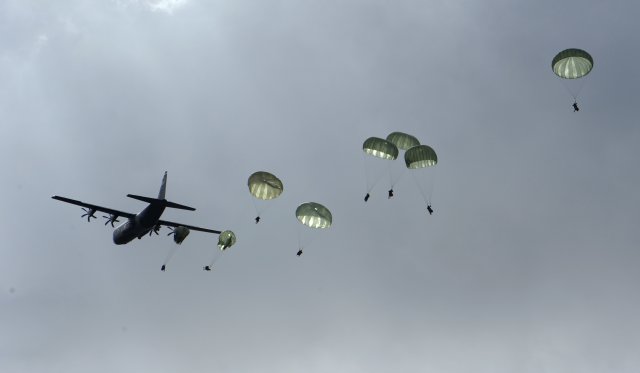Sky Soldiers, paratroopers of the 173rd Airborne Brigade Combat Team descended on the drop zone at Hohenfels Training Area, Oct. 5, in Europe’s first full-spectrum training environmen, or FSTE rotation.
The concerns are always the same, the Soldiers avoid falling in on objects that might be in their way, but unlike Afghanistan where rocks, trees and mountains are everywhere, this training is different. It’s not focused on counter-insurgency, or COIN. Instead Europe’s rapid reaction force is exercising doctrine on wide-area security and combined-arms maneuver.
The complex exercise pits the conventional opposing force with tanks, helicopters and unmanned aerial systems against conventional and unconventional enemies and the criminal element.
“We’ve taken what we know, based upon our experiences fighting insurgencies, and applied that information to the Army’s most recent full-spectrum operations doctrine,” said Col. Jeffrey R. Martindale, the commander of the operations group at the Joint Multinational Readiness Center, or JMRC, at Hohenfels. “The result is a hybrid threat environment in which our forces must contend with a complex mix of both conventional and unconventional enemies.”
At JMRC, nearly all of the cadre, observer-controllers and trainers, including the professional opposing forces, the 1st Battalion, 4th Infantry Regiment, have deployed to Iraq, Afghanistan or both. In January of 2011, the 1-4 redeployed its last company of Soldiers from Afghanistan, ending a six-year mission in theater in partnership with the Romanian Land Forces.
This FSTE rotation has more than 7,500 participants from 17 countries. Planners say the U.S. and multinational forces training together is unusual. There is a Slovakian battalion supporting the 1-4 and role-playing the opposing force, while Slovenian and Polish units are supporting the 173rd replicating the host-nation forces, said Martindale.
During Operation Enduring Freedom, 86 percent of non-U.S. coalition troops came from the European theater. The 7th Army Joint Multinational Training Command, or JMTC, the U.S. Army’s only forward-deployed training command trains those forces regularly. Some of those same forces are participating in this training event. Likewise, there are participants from the U.S. Air Force and the Army’s National Guard and Reserve components.
“We are able to train as we fight in Europe. Because of our forward-deployed location we are able to have multinational Soldiers to work with us and right-seat-ride with us in training and in theater,” said Col. Bryan L. Rudacille, commander of the JMTC. “As our multinational partners continue to train with U.S. service members, we prevent future conflicts, have the ability to prevail over any threat, while preserving stability in the region. Preparation is the key, and that’s what we are doing, during this FSTE rotation and every day.”
The FSTE, being held Oct. 3-24, at the Grafenwoehr and Hohenfels Training areas in Germany, is the proof-of-principle exercise in Europe, and for many 173rd Soldiers, it’s likely to be the first time they’ve had to maneuver against 50-plus “tanks,” and other equipment not used during the current conflict because of unique COIN requirements.
Army Field Manual FM 3-0 says full-spectrum operations, or FSO, empowers a commander to employ synchronized action, lethal and nonlethal, which is proportional to the mission based on an understanding of his units capabilities. As Europe, implements the FSO, the Army released another Army Doctrine Publication 3-0, which covers Unified Land Operations.
Seasoned-Soldiers refer to the new doctrine as getting back-to-basics, the old way the Army used to train, however, some say it’s not possible to ignore lessons learned during Operation Iraqi Freedom and OEF. The U.S. Army in Europe is applying those lessons-learned, which includes coalition building and the value of training together, especially when deploying together.
Planning for the FSTE took more than six-months as staff regained proficiency in skills, such as, airborne operations, serving as the opposing force and working with the multinational forces in expanded roles.
“In the early stages of an entry operation like this, they have to jump-in and it’s chaotic initially, and they are going to rapidly develop the situation and expand their operations and start growing their forces,” said Col. John R. Jones, a senior intelligence officer. “In the FSTE, they are establishing for the first time communications, a command post, fighting positions, logistical support, and developing situational understanding of the operational environment.”
According to Jones, the jump and early-entry operation is just the beginning. The rest remains to be seen.










